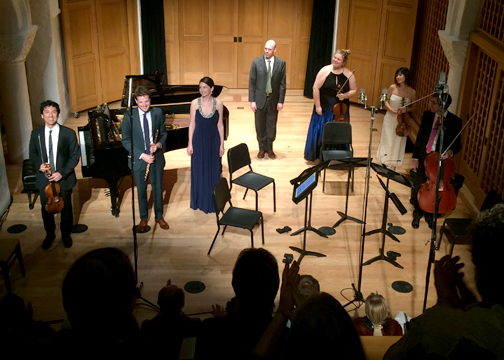
Members of the Salastina Society receive applause after their Apr. 1 program at the Pasadena Conservatory of Music. From left to right: Kevin Kumar, Benjamin Smolen, Greta Bachhuber, Gideon Rubin, Meredith Crawford, Hana Hwon Kim, and Peter Myers.
Programming – the selection of works to be played at a performance of classical music – can be crucial. In the right hands, it not only makes for an appealing spectrum of contrasting and complementing colors, but it also sets the listeners’ ears on a journey in which these works not only stand alone, but are also contextualized within the greater environment that surrounds them. It’s a kind of storytelling in which piece after succeeding piece draws the listener along the compelling thread of narrative spool being drawn before them. In this regard, the performances last weekend by Salastina Society and Le Salon de Musiques revealed not only the superlative polish of their musicians, but their uncanny ability to weave programs that can be illuminating and even surprising.
The Salastina Society’s concert at the Pasadena Conservatory of Music on Saturday was, in effect, a snapshot of New England tinted with nostalgia.
Each composer on the program – Charles Ives, Arthur Foote, Walter Piston, Aaron Jay Kernis and Amy Beach – had lived or worked extensively in the region. They also shared an outlook that gazed towards Europe – Germany in particular – and they all shared a conservative, classicist aesthetic. The notable exception as far as the latter was concerned was Ives, who was represented by four songs, though the ones chosen sat in the tradition of parlor music rather than the cantankerous, crazy-quilt modernism he’s best remembered for.
Sung with honeyed glow and smoothness by Greta Bachhuber, the songs were interspersed throughout the program like autumnal ghosts flickering amidst the play of afternoon light filtered through the shadows of trees in the Spencer State Forest, then vanishing beneath the cascading foliage of red, brown and orange.
Equally superlative were the Salastina instrumentalists. Composed of flautist Benjamin Smolen, violinists Kevin Kumar and Hana Hwon Kim, violist Meredith Crawford, cellist Peter Myers, and pianist Gideon Rubin, the group played with fine polish and blend, putting into perspective these composers’ shared Brahmsian vocabulary. (The Coplandesque “Air” by Kernis and the knotty Shostakovichian “Duo for Viola and Cello” by Piston were outliers somewhat, though they shared the earlier composers’ conservative leanings.)
Another story was told with equal persuasion by Le Salon de Musiques on Sunday.
There it was a neat encapsulation of the history of the salons that were the nursing grounds for French art and thought in the 18th through the early 20th centuries. The works by the three composers on the program neatly illustrated the primacy of the salon in French artistic life, as well as its rise and fall.
The attractive, if somewhat gauche “Piano Trio in G” by the 18-year-old Claude Debussy, was the work of a young man hoping to make his name in the salon. In his case, in the ones held by Nadezhda von Meck, his employer at the time (and better known as Tchaikovsky’s patron). The sparkling “Piano Trio No. 2 in A minor” by Cécile Chaminade was a portrait of the salon at its height, its glittering pianistic passagework tailor-made to please its patrons. The late “Piano Trio in D minor” by Gabriel Fauré, on the other hand, was a work that transcended the conventions of the salon. It was ironic to consider that it had been Debussy who had once dismissed Fauré as a “master of charms.” The apprentice work by the younger composer evinced much (understandable) contrivance to please. The late work by the elder composer, while possessing a serene beauty, was a spare and uncompromising score that would have likely passed over the heads of some of its well-heeled first listeners.
Standing apart was an early miniature by Zoltan Kodály, an “Adagio” for violin and piano, played with poise and nuance by Serena McKinney.
Her partners, cellist Eric Byers and pianist Kevin Fitz-Gerald, played with sharply honed senses of rhythmic and textural coloring. They displayed not only enviable unanimity of ensemble, but also equal parts purpose and delight in unfurling the narrative of this beautifully assembled Le Salon de Musiques program.
